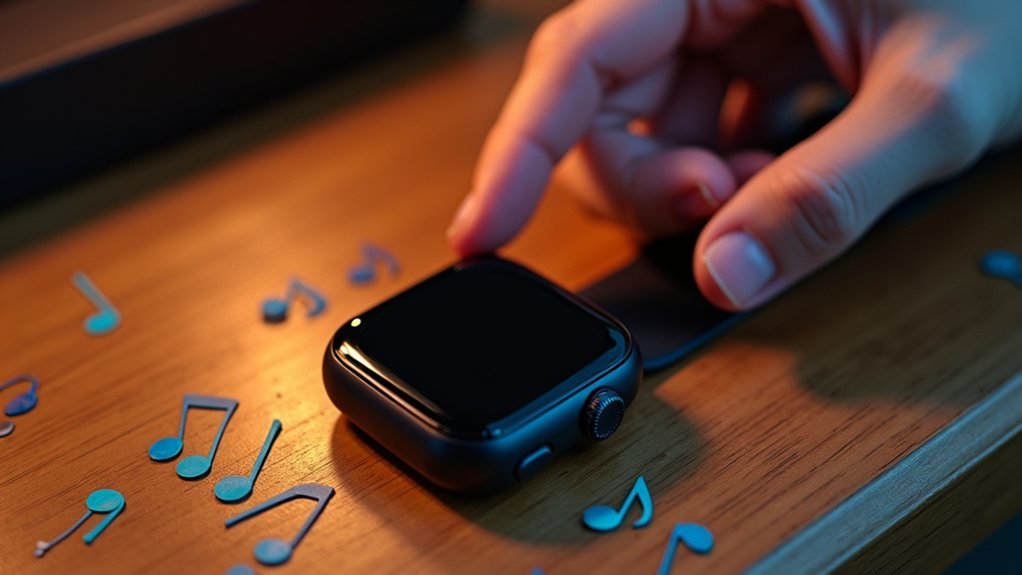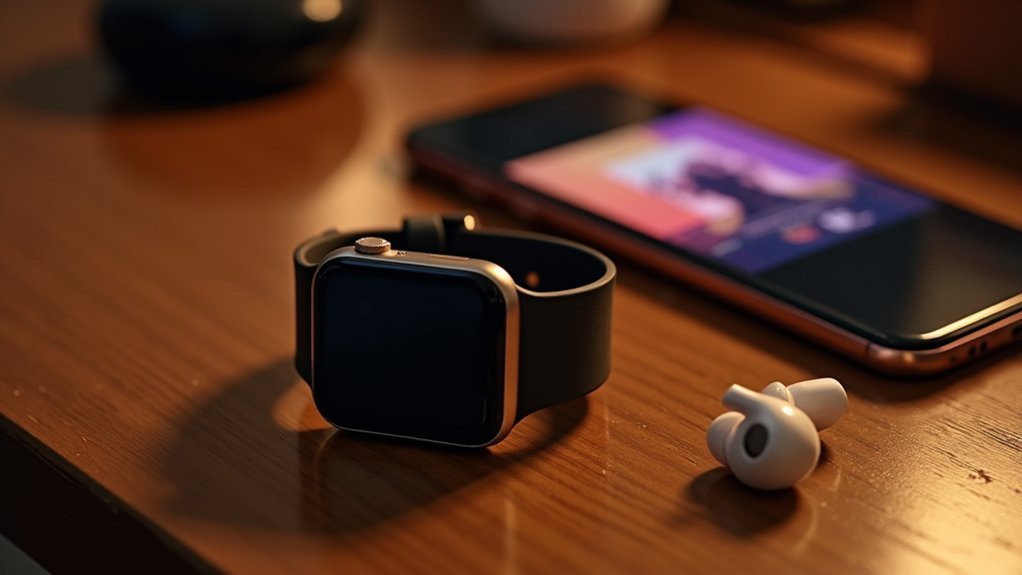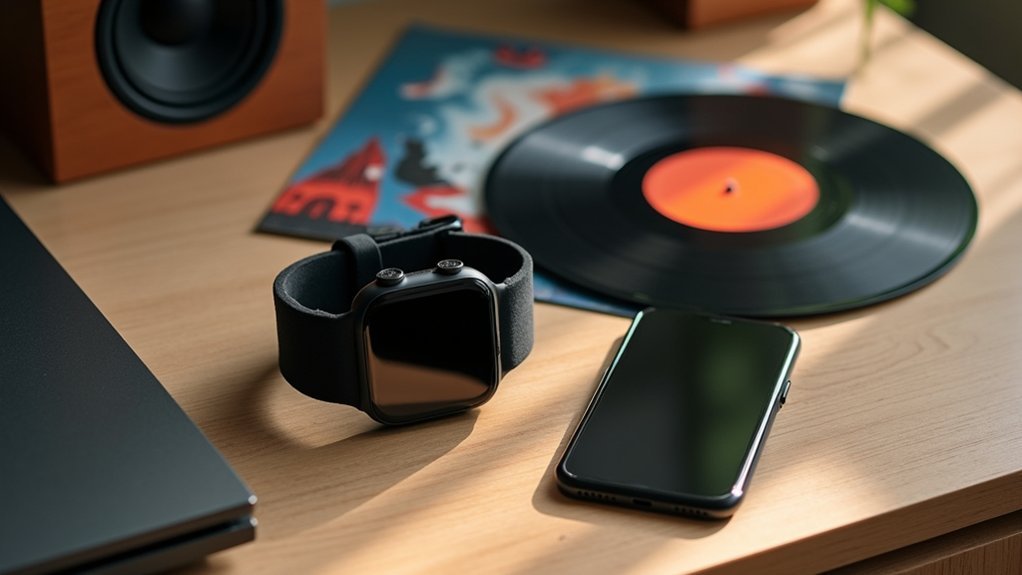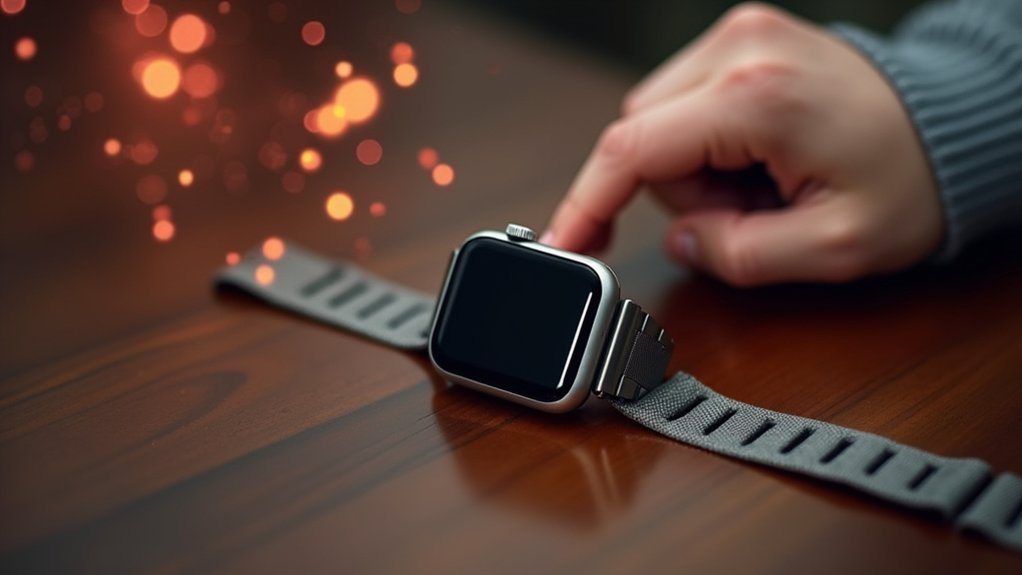You can control music from your smartwatch using dedicated playback buttons for play, pause, skip, and volume adjustments directly on your wrist. First, download compatible streaming apps like Spotify or YouTube Music from your smartwatch’s app store, then pair Bluetooth headphones by enabling pairing mode and connecting through your watch’s settings. You’ll also want to transfer music files locally using device-specific apps for offline listening. Explore these extensive setup strategies to access your smartwatch’s full audio potential.
Essential Playback Controls for Smartwatch Music Management

While modern smartwatches offer dozens of features, their music playback controls remain among the most frequently used functions for daily users. You can play and pause your music using dedicated buttons or simple touch gestures directly on your watch face.
Skip tracks forward or backward with specific buttons, eliminating the need to reach for your phone. Volume adjustment happens right from your wrist, letting you control sound levels instantly during workouts or commutes.
Your smartwatch also provides repeat and shuffle options, giving you control over playlist variety. The stop and resume functionality proves invaluable during interruptions, allowing you to pick up exactly where you left off without missing a beat of your favorite songs.
Galaxy smartwatch users can access their music library directly from the watch interface for seamless control over their stored tracks.
Setting Up Music Streaming Apps on Your Smartwatch
You’ll need to download compatible music streaming apps directly to your smartwatch to access your favorite services.
Start by checking your watch’s app store for supported apps like Spotify, YouTube Music, or Apple Music that work with your specific device model. Spotify requires watchOS 8.0 or later for Apple Watch compatibility.
Once downloaded, configure the streaming settings by logging into your accounts and adjusting preferences for offline downloads or cellular streaming based on your subscription and connectivity options.
Download Compatible Apps
When you’re ready to transform your smartwatch into a music powerhouse, downloading compatible streaming apps is your first essential step.
Start by identifying which apps work with your specific device. Galaxy Watch users can access Spotify, YouTube Music, and SoundCloud, while Apple Watch supports Apple Music and Spotify through iPhone pairing. Garmin Venu 2 owners enjoy compatibility with Spotify and Amazon Music, plus substantial built-in storage for offline content.
You’ll need to set up these apps from your paired smartphone first before using them on your watch.
Consider subscription requirements – YouTube Music and SoundCloud need premium plans for offline downloads, while Spotify offers extensive playlist downloading capabilities. The Galaxy Watch 6 provides 16 GB storage for your music needs, ensuring ample space for your favorite tracks and playlists.
Choose apps that match your listening habits and subscription preferences for ideal smartwatch music control.
Configure Streaming Settings
After installing your preferred music apps, proper configuration guarantees smooth streaming performance on your smartwatch.
First, make sure both your watch and paired device connect to the same Wi-Fi network for stable connectivity. Samsung users should activate Music Manager through the Music app to enable file transfers and library management.
Connect Bluetooth headphones to your smartwatch for hands-free listening.
Most streaming services require paid subscriptions for direct downloads, so log into your music apps using premium accounts to access full libraries. YouTube Music requires a YouTube Premium account to function properly on compatible Garmin smartwatches.
Transfer music files using compatible formats like MP3, M4A, AAC, OGG, and WMA through companion apps like Galaxy Wearable.
Preload favorite tracks onto your watch to reduce streaming dependency and conserve battery life during workouts or offline situations.
Transferring Music Files From Phone to Smartwatch

You can transfer music files from your phone to your smartwatch using several methods, with the specific approach depending on your watch brand and model.
Samsung Galaxy Watch users will rely on the Galaxy Wearable app, while Google Pixel Watch 2 owners can use apps like WearMedia Musik Player for file transfers. This allows you to listen directly from the watch without needing to carry your phone during activities like running.
Before starting any transfer, you’ll need to verify your music files are in supported formats and that you have the appropriate apps installed on both devices.
Transfer Methods and Apps
Several methods exist for transferring music files from your phone to your smartwatch, each depending on your device’s compatibility and preferred connection type.
You’ll need to use specific transfer apps based on your smartwatch model. Samsung users rely on the Galaxy Wearable app, while iOS users can utilize Music Manager for cross-platform transfers via Wi-Fi. Huawei Watch GT owners should use the Huawei Health app for seamless music management.
Key transfer methods include:
- Bluetooth connectivity for direct device pairing and file transfer
- Wi-Fi transfer enabling faster data speeds for larger music libraries
- Auto-sync functionality when your smartwatch battery exceeds 15%
- Selective file transfer allowing you to choose specific tracks or albums
- Cross-platform support for Android and iOS compatibility
Some smartwatches require connection to a computer using charging pins for direct file management when wireless transfer options aren’t available.
Ensure you’ve got stable connectivity before initiating transfers.
Supported File Formats
Understanding which audio formats your smartwatch supports will save you time and frustration during the transfer process. MP3 remains universally supported across all major smartwatch brands, while AAC offers another reliable option for music playbook.
| Brand | Supported Formats |
|---|---|
| Samsung Galaxy | MP3, M4A, AAC, OGG, WAV, WMA, AMR, AWB |
| Garmin | MP3, M4B (audiobooks) |
| Huawei | MP3, AAC (with bitrate caps) |
Most watches prioritize compressed formats like MP3 and AAC for space efficiency. You’ll encounter bitrate restrictions—typically 320 Kbps limits for MP3/AAC files. While your watch might support certain formats, the default music app may not recognize all transferred files. Third-party apps often expand compatibility beyond stock players, especially for advanced formats like M4A and OGG. For optimal music management, use your preferred media management program to organize and create playlists before syncing to your smartwatch.
Supported Audio File Formats for Smartwatch Storage
Different smartwatch brands support varying audio file formats, with MP3 being the most universally compatible option across devices. When storing music locally on your smartwatch, you’ll need to take into account your device’s specific format limitations to guarantee smooth playback.
Here are the key formats supported by major smartwatch brands:
- Garmin watches – Support MP3 and M4B (audiobook) formats
- Huawei watches – Accept MP3 and AAC files under 320Kbps
- Samsung Galaxy Watch – Offers extensive support including MP3, M4A, AAC, OGG, WAV, WMA, and AMR
- General compatibility – MP3 remains the safest choice across all brands
- Third-party apps – Can expand format support beyond native capabilities
Consider that lossy formats like MP3 and AAC are particularly well-suited for smartwatch storage due to their smaller file sizes, which help maximize your device’s limited storage capacity. You’ll want to convert incompatible files using conversion tools before transferring them to your smartwatch for peak performance.
Maximizing Storage Capacity for Offline Music Libraries

While smartwatch storage varies dramatically between models, you’ll need to work within tight constraints to build a meaningful offline music library. Most smartwatches offer limited space—Amazfit Active provides just 250MB, while Apple Watches restrict music to 24% of available storage.
For best results, aim for devices with at least 4GB capacity, though premium options like Samsung Galaxy Watch Ultra offer 32GB.
Maximize your storage by compressing music into MP3 or AAC formats without significant quality loss. Manually sync only essential tracks rather than entire libraries, and create regularly updated playlists to maintain fresh content.
Regularly clean unused songs and consider cloud service integration to reduce local storage demands. Modern smartwatches with Bluetooth connectivity allow seamless music control even when your phone handles the actual storage and streaming. These strategies help you maintain meaningful offline access while working within your smartwatch’s storage limitations.
Connecting Wireless Headphones to Your Smartwatch
Pairing wireless headphones with your smartwatch transforms it into a truly independent music device, eliminating the need to carry your phone during workouts or daily activities.
Before starting, verify both devices are charged and place your headphones in pairing mode by holding the designated button until you see flashing lights or hear an audio prompt.
Here’s how to complete the connection:
- Navigate to Settings or Connections on your smartwatch’s main screen
- Select Bluetooth and enable it if it’s not already active
- Keep headphones within 30 feet of your watch during pairing
- Tap your headphone name when it appears in available devices
- Wait for confirmation message indicating successful pairing
Test the connection by playing audio to verify sound flows through your headphones properly. After pairing, access the settings icon next to your connected headphones to enable both call audio and media audio for complete functionality.
Volume Control and Audio Settings Optimization
You can adjust your smartwatch’s volume directly from the device using touch controls or the digital crown, giving you instant control over your music’s loudness.
Most smartwatches offer basic audio quality settings that let you optimize sound output for different types of headphones or speakers you’ve connected.
These volume and audio adjustments work whether you’re playing music stored locally on your watch or streaming from your paired smartphone. If you experience unwanted audio playback through your smartwatch during YouTube or music sessions, you can prevent this by accessing your Bluetooth settings and toggling off the audio option for your connected device.
Adjusting Volume Levels
Once you’ve connected your smartwatch to your preferred music app, controlling volume becomes surprisingly intuitive through multiple input methods.
Your watch offers several ways to adjust audio levels depending on your device’s capabilities and current situation.
- Touchscreen controls – Swipe or tap volume sliders directly on your watch face for quick adjustments.
- Physical buttons – Use dedicated volume up/down buttons or rotate bezels/dials when available.
- Voice commands – Tell your assistant “volume up” or “set volume to 50%” for hands-free control.
- Gesture controls – Some models respond to specific hand movements for volume changes.
- Widget access – Add volume control widgets to your watch face for instant availability during workouts.
These controls automatically sync with your paired Bluetooth headphones, ensuring consistent audio levels across devices. Most modern smartwatches are compatible with various music streaming services, allowing seamless volume control regardless of your preferred platform.
Audio Quality Settings
While volume control handles the basic loudness of your music, enhancing your smartwatch’s audio quality settings can dramatically improve your listening experience through codec selection, equalizer adjustments, and device pairing strategies.
Enable Developer Mode on your paired smartphone to access higher-quality audio codecs like Samsung’s Scalable Codec, which automatically adjusts bitrate from 88kbps to 512kbps based on signal strength. Select HD Audio mode for compatible wireless earbuds to reduce latency and improve clarity.
Use your smartwatch’s companion app to customize EQ settings, adjusting bass, treble, and balance for your preferences.
Enable Dolby Atmos on your phone for immersive 3D sound. Pair official brand earbuds with your smartwatch to reveal special features like 360 Audio and Gaming Mode, ensuring ideal codec support and audio stability. If you experience audio issues, check that your smartwatch isn’t connected to unwanted Bluetooth audio devices that might be intercepting your music stream.
Managing Music Libraries Through Companion Apps
Where traditional music players require constant phone interaction, smartwatch companion apps revolutionize how you manage your entire music collection directly from your wrist.
These apps provide thorough library management that goes beyond basic playback control. You’ll access your complete music catalog, create playlists, and organize tracks without touching your phone. Cloud synchronization guarantees your library stays consistent across all devices, while offline storage capabilities let you enjoy music independently.
Modern smartwatch apps like iHeart for Wear OS 3 deliver seamless streaming that transforms your wrist into a complete audio hub without requiring phone connectivity.
Key companion app features include:
- Direct library browsing – Navigate playlists, genres, and recently played tracks
- File transfer capabilities – Move songs and podcasts via Bluetooth with progress tracking
- Custom organization tools – Add tags, notes, and favorite markings for better management
- Cross-device synchronization – Automatic cloud sync keeps libraries updated everywhere
- Sharing integration – Send tracks to friends through messaging apps and social features
Using Voice Commands for Hands-Free Music Control
Why fumble with tiny touchscreens when your voice can instantly control your music? Voice assistants like Siri, Google Assistant, and Bixby transform your smartwatch into a hands-free music controller.
You’ll need to pair your watch with your smartphone and enable voice features through settings or companion apps.
Simple commands like “play,” “pause,” “skip,” or “volume up” let you control playback without lifting a finger. You can search for specific songs, manage playlists, and open music apps like Spotify or Apple Music.
This hands-free approach shines during workouts, driving, or when multitasking. Modern smartwatches enhance productivity by choosing optimal connections between Bluetooth, Wi-Fi, and cellular networks to ensure smooth music streaming.
However, voice commands struggle in noisy environments and may not recognize all accents.
Check your smartwatch’s compatibility, as not all models support advanced voice features for seamless music control.
Integrating Music Control With Fitness Tracking Features
Beyond voice commands, your smartwatch becomes a powerful fitness companion when you integrate music control with workout tracking.
You’ll discover how your device synchronizes entertainment with exercise data to enhance your performance.
Your smartwatch seamlessly combines music and fitness features:
- Workout Mode Integration – Select specific exercise modes while your music automatically adjusts to match your activity intensity.
- Heart Rate-Based Tempo – Monitor your heart rate and let your smartwatch suggest music tempos that align with your target zones.
- GPS Route Enhancement – Track your running or cycling routes while controlling playlists without breaking stride.
- Recovery-Based Playlists – Access post-workout music recommendations based on your recovery metrics and training readiness.
- Custom Exercise Soundtracks – Create activity-specific playlists that sync with different workout phases and intensities.
Modern fitness watches provide comprehensive health monitoring by tracking your daily step count alongside music controls, ensuring you stay motivated throughout your entire fitness journey.
Android Vs Ios Music Management Differences
When you’re choosing between Android and iOS for smartwatch music management, you’ll encounter significant differences that directly impact your daily listening experience. Android smartwatches offer seamless integration through the Galaxy Wearable app, supporting multiple file formats like MP3, AAC, and OGG for direct transfer. You’ll enjoy broader app compatibility with Spotify, YouTube, and native players.
| Feature | Android | iOS |
|---|---|---|
| Transfer Method | Direct app-based | Web interface via IP |
| App Support | Multiple music apps | Limited integrations |
| File Management | Drag-and-drop simplicity | Manual network setup |
iOS pairing creates more hurdles. You’ll need Wi-Fi connections and browser-based Music Manager interfaces for transfers. Apple’s ecosystem restrictions limit streaming service integration and app installation options, resulting in more basic on-watch controls and a cumbersome overall experience compared to Android’s streamlined approach. Android’s superior music control capabilities allow you to skip tracks, adjust volume, and pause directly from your wrist with greater convenience.
Troubleshooting Common Music Playback Issues
Even with perfect platform compatibility, you’ll inevitably encounter music playbook problems that disrupt your listening experience.
Despite flawless device compatibility, music playback glitches will still occur, requiring quick troubleshooting to maintain your seamless audio experience.
When your smartwatch stops controlling music properly, systematic troubleshooting will restore functionality quickly.
Start with these essential fixes:
- Restart both devices – Power cycle your smartwatch and phone to resolve temporary connectivity glitches
- Update everything – Install latest firmware for your smartwatch and update music apps to prevent crashes
- Check Bluetooth pairing – Verify devices are properly connected and move closer to strengthen signal
- Clear app cache – Remove stored data from music apps that might cause performance issues
- Reset smartwatch settings – Return to factory defaults if problems persist after other attempts
Additionally, reduce screen brightness and disable unnecessary background apps to improve your smartwatch’s battery performance during extended music sessions.
For persistent issues, reinstall music apps or contact customer support for device-specific solutions.
Best Practices for Battery Life During Music Streaming
Music streaming transforms your smartwatch into a portable entertainment hub, but it’s also one of the most battery-intensive activities your device performs. Maximize your listening time by downloading music locally instead of streaming, which notably reduces wireless radio usage.
Turn off “Raise to Wake” features and use the lowest comfortable screen brightness with short timeout settings. Disable Always-on Display and consider dark watch faces for OLED screens.
Optimize connectivity by turning off LTE when unnecessary and disabling GPS during playback. Lower your volume to comfortable levels and pause music during breaks.
Enable battery-saving modes that disable non-essential functions, turn off continuous heart rate monitoring, and minimize vibration alerts. Since battery performance is closely tied to usage habits, regularly reviewing and adjusting your settings based on how you use your smartwatch can lead to optimal power management. These adjustments can considerably extend your music streaming sessions.
Frequently Asked Questions
Can I Control Music on Multiple Devices Simultaneously From One Smartwatch?
You can’t directly control music on multiple devices simultaneously from one smartwatch. Your watch controls playback through your connected phone, which can potentially stream to multiple devices if they’re synced together.
Do Smartwatches Support Lossless Audio Formats Like FLAC or ALAC?
Most smartwatches don’t natively support FLAC or ALAC formats. You’ll find they’re limited to standard formats like MP3 and AAC. Third-party apps or firmware modifications might enable lossless support on select models.
How Much Does Music Streaming Affect My Smartwatch’s Monthly Data Usage?
Music streaming on your smartwatch typically uses minimal data since it relies on your connected phone’s connection. However, if you’re streaming independently, expect 42-144MB per hour depending on quality settings you’ve chosen.
Can I Create Custom Playlists Directly on My Smartwatch Without Phone?
You can create custom playlists directly on your smartwatch without a phone using Wear OS devices, apps like WearMedia, or Suunto watches that support offline music management and playlist creation.
Which Music Services Offer the Best Smartwatch App User Experience?
You’ll find Apple Music offers the smoothest smartwatch experience with seamless integration, while Spotify provides excellent cross-platform compatibility. Tidal delivers superior audio quality, and YouTube Music combines both audio and video content effectively.
In Summary
You’ve now mastered the fundamentals of controlling music from your smartwatch. Whether you’re streaming from apps, storing files locally, or managing playback during workouts, you’ll enjoy seamless audio control right from your wrist. Remember to optimize your storage, monitor battery usage, and troubleshoot any connectivity issues that arise. With proper setup and these best practices, your smartwatch becomes the perfect music companion for any activity.





Leave a Reply